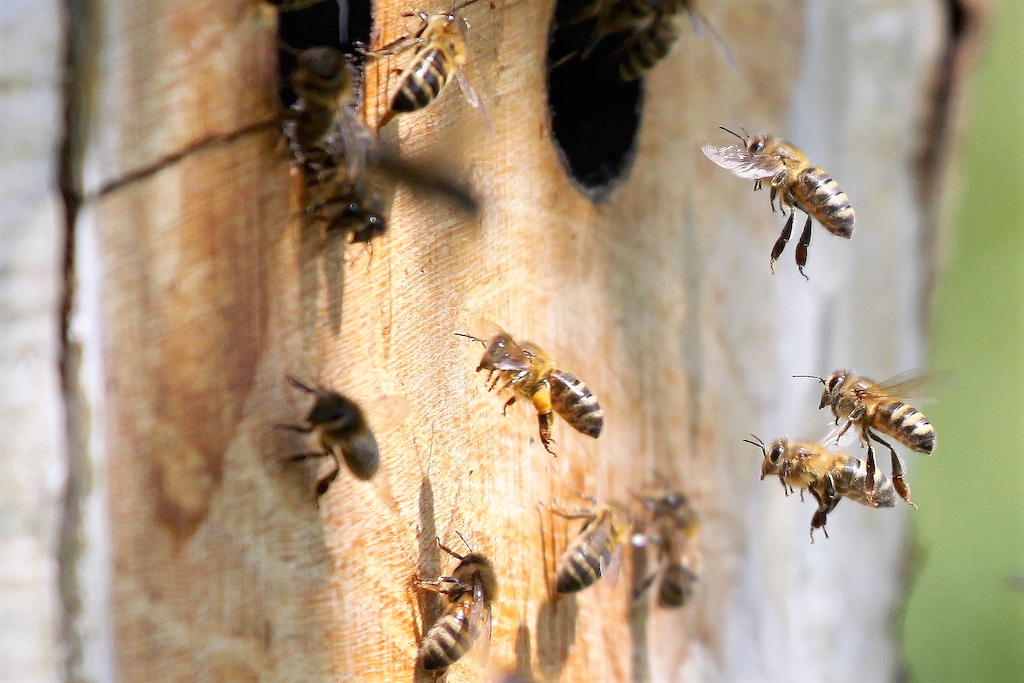 This article describes the work that two of our members are undertaking around Boussac and in Holland. Henriette van Donkelaar and Herman van der Kuil are trying to preseve and boost the wild bee population using methods best suited to the bees natural environment.
This article describes the work that two of our members are undertaking around Boussac and in Holland. Henriette van Donkelaar and Herman van der Kuil are trying to preseve and boost the wild bee population using methods best suited to the bees natural environment.
At present there are 5 beehives installed in Boussac and surrounding areas. Some paid by sponsors and some paid by the landowners. Amitiés Internationales du Pays de Boussac will be funding an additional hive this year to be installed in the countryside around Boussac.
They were inspired by Adam Wright and Karin Maassen, they organised a lecture about bees and made Henriette and Herman very enthusiast.
The following article provides the details of how and why this is important to us as mere humans and to the wildlife.
The natural beehives of Custos Apium
 Recent news stories have told us how important bees are to us, but are you aware of what is important to them?
Recent news stories have told us how important bees are to us, but are you aware of what is important to them?
If we really want to help save the bees we need to look at what we do for them, with them and from their point of view. To encourage growth of healthy bees we need to offer them a natural habitat where they can be left undisturbed, store their honey for themselves and grow healthily.
In nature, bees (honeybees) prefer to live in natural cavities in trees or rock formations. They have lived like this for about 350 million years with great success. In their natural environment they have proved to be perfectly capable of adapting to climatic changes, they have survived diseases and other pests and have spread and multiplied, purely because they had the opportunity to behave like bees, without human interference, without their honey being taken because, they lived in a healthy habitat, self-selected and tailored to their needs.
Completely undisturbed is best
The hives of Custos Apium are developed with a bees natural habitat as a starting point and with the aim to help strengthen and maintain the bee population and offer the healthy reproduction of the wild honey bee.
The inside of the Custos hive is based on what research has shown to be the ideal size for bees to make their nest, rear their family and store enough food (honey) to survive the winter. The inside is not too big so that there are no empty (cold/humid) areas, otherwise the bees could get separated from their food supply in the winter, which leads to the death of the colony.
The hives are insulated with natural materials and have two openings, one of which is round like in a tree, which attracts bees naturally. Then we leave the bees completely alone, we don’t open the hive and don’t take out frames just to see what is happening. The bees build their own honeycomb there is no need to put in any pre-formed wax.
We don’t interfere with our hives and we abstain from the many modern beekeeping techniques and treatments. Opening the hive for inspections puts enormous strain and stress on the bees, disturbs their nest, warmth and hive balance. Our hives function as nesting sites, the perfect natural habitat and therefore don’t require much, if any, work from the beekeeper.
 Honey a small gift only
Honey a small gift only
This hive has the possibility to take a small amount of honey, but no more than that and must be done without any disturbance to the bees’ nest. Bees make honey to feed young bees and themselves and survive the winter in good health. Harvesting large amounts of honey (and then replacing it with sugar) does not fit into our philosophy.
We offer bees a home to survive in, to be strong and healthy and to be able to multiply. In the end, it’s more important to have a healthy bee population to fertilize our food than a spoonful of honey in our tea. Occasionally it can be very tasty, but simply it is not a necessity for us ‘humans’.
 The swarm and its quest
The swarm and its quest
Our hives are usually placed high, just like a cavity in a tree is never on the ground. Placing them on a platform in a tree is ideal, but a garden wall, a flat roof or a raised stand is also fine. The swarm will find the hive during its search for a new home in the spring.
Every Custos Apium hive installed, offers a swarm a good home, a vegetable garden good food production and many a nature lover a nice view of the busy bees.
For anyone who would like to know more about bees and/or is thinking about having a beehive in the garden.
Karin and Adam will come to Boussac to give a lecture about bees, hosted by AIPB and Custos Apium and we’ll explain what is actually going on in a beehive.
We will talk about how bees live in nature, how they function, what is important for the bees, and how, knowing what they need, and don’t need, we can help them be strong and healthy so they can survive. This is not about beekeeping, but about bees, and looking after them. We will have a look at our hives and answer your questions about bees and beecentric beekeeping.
10 april 2019 20h00 till 21h00
Maisons des Associations. Boussac


3 responses to “Wild Honey Bees”
[…] Read the full story… […]
LikeLike
I have a large garden in a very rural area surrounded by trees, I think it’s perfect for the wild bees, how do I get a hive installed and is my garden suitable.
LikeLike
Thank you for your comment Keith, I have asked our members who are organising this to contact you direct.
LikeLike